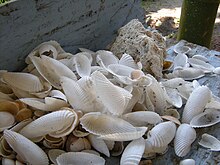
Back Skulp Afrikaans صدفة بحرية Arabic Balıqqulağı (əhəng daşı) Azerbaijani Ҡабырсаҡ Bashkir Ракавіна BE-X-OLD Раковина Bulgarian Káe̤k-siŏh CDO ᎤᏯᏍᎦ CHR Schránka Czech Шапа хуранӗ CV
This article needs additional citations for verification. (January 2009) |
| Part of a series on |
| Seashells |
|---|
 |
| Mollusc shells |
| About mollusc shells |
| Other seashells |





A seashell or sea shell, also known simply as a shell, is a hard, protective outer layer usually created by an animal or organism that lives in the sea. Most seashells are made by mollusks, such as snails, clams, and oysters to protect their soft insides.[1] Empty seashells are often found washed up on beaches by beachcombers. The shells are empty because the animal has died and the soft parts have decomposed or been eaten by another animal.
A seashell is usually the exoskeleton of an invertebrate (an animal without a backbone), and is typically composed of calcium carbonate[1] or chitin. Most shells that are found on beaches are the shells of marine mollusks, partly because these shells are usually made of calcium carbonate, and endure better than shells made of chitin.
Apart from mollusk shells, other shells that can be found on beaches are those of barnacles, horseshoe crabs and brachiopods. Marine annelid worms in the family Serpulidae create shells which are tubes made of calcium carbonate cemented onto other surfaces. The shells of sea urchins are called "tests", and the moulted shells of crabs and lobsters are exuviae. While most seashells are external, some cephalopods have internal shells.
Seashells have been used by humans for many different purposes throughout history and prehistory. However, seashells are not the only kind of shells; in various habitats, there are shells from freshwater animals such as freshwater mussels and freshwater snails, and shells of land snails.
- ^ a b "How are seashells made?". Woods Hole Oceanographic Institution. Retrieved 14 May 2024.